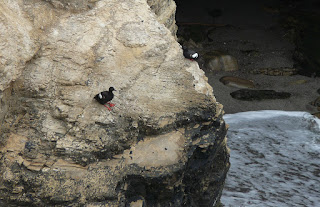Update - Cloisters Pond - Good News! At the back of the pond, a few weeks after my April 5th posting, four tiny Grebes appeared. A week later an additional three little Grebes appeared at the font of the pond; all have grown to maturity. Considering the hungry Hawks and Raccoons that frequent the area, their survival rate is amazing.
Update - Black Oystercatcher - Oystercatchers are nesting at Montaña de Oro. A monogamous pair makes a nest by tossing rock flakes, pebbles, or shell fragments toward their chosen nest site. Two eggs can be seen in a nest, located on a seamount about 100 feet from the cliff. Only one egg is visible (nest circled in red). Unfortunately, anytime a person walks out to the point, the Oystercatcher gets off the nest; when the person finally moves on, the Oystercatcher returns to the nest. The photo by Mike Baird shows the proximity of the nest to the people standing on the trail. Unfortunately, the viability of the nest depends on how many people walk out on this popular trail and how long they spend looking at the view. This area is also popular with fisherman.
Update - Pigeon Guillemots - The action continues - Guillemots are dashing between rocks and the water and the water and the holes in the cliff, but much to my disappointment I have yet to find a nest that I can actually recognize as a nest. The Guillemots are numerous, so there is hope that some are nesting. A juvenile Guillemot usually leaves the nest at night; they flutter and tumble from the cliffs to the sea. Once in the sea, it will take another couple of weeks for their flight feathers to fully develop. I am thinking positively that during those weeks, I will see a juvenile Guillemot before it fully matures and flies out to sea.
I am afraid that our love of nature is taking its toll on the nature we love.
Subscribe to:
Post Comments (Atom)




No comments:
Post a Comment